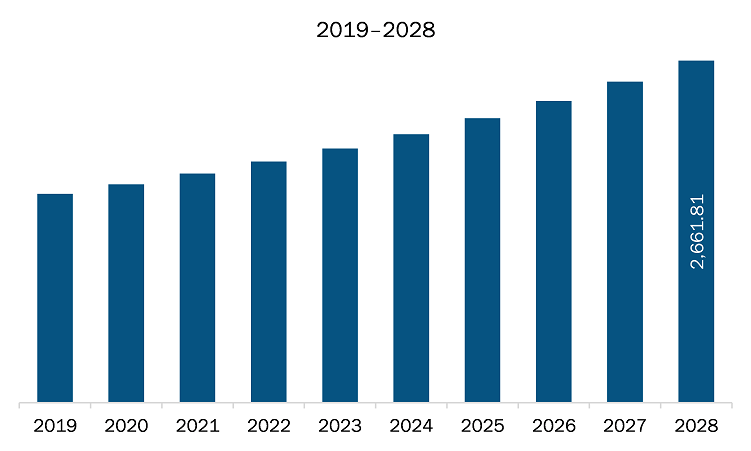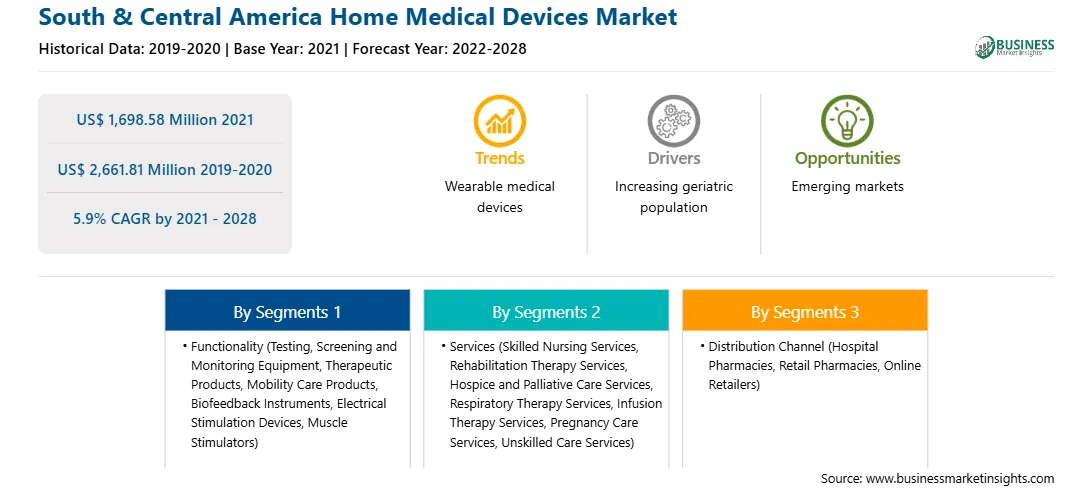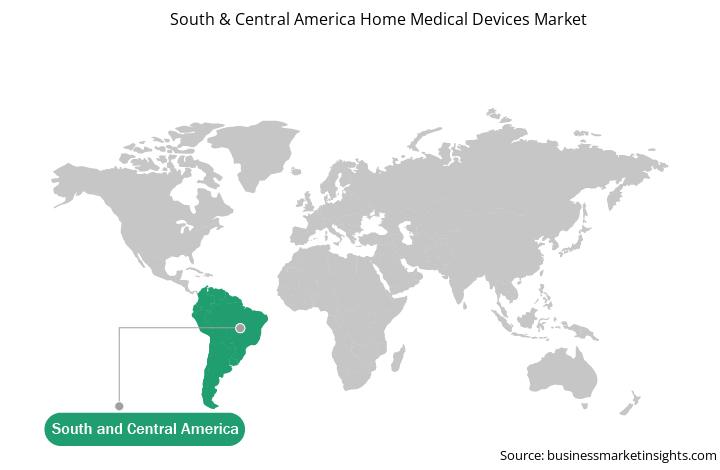South and Central America (SCAM) region consists of Brazil, Argentina, and Rest of South and Central America. Brazil is expected to have the major market share in this region. Also, it is projected to grow with highest growth rate. Aging population coupled with increasing demand for advanced medical technologies are expected to accelerate growth of the home medical devices market. Brazil is the fifth largest country in the world both by area and by population and experiencing the fastest demographic aging worldwide. In Brazil, the aging population is at a rapid pace and in a context of regional and historical socioeconomic inequalities. According to the study conducted in Brazil, the community of women estimated at the vast majority with 16.9 million (56%) of elderly persons, whereas older adults estimated approx. 13.3 million (44%). The growing aging population leads to several chronic conditions such as cancer, orthopedic conditions, neurodegenerative disorders, and diabetes amongst others. Such growing conditions are likely to drive the adoption of medical devices, which will eventually drive the Brazil medical devices market during the forecast period. Furthermore, product developments by the companies in the brazil is likely to favor market growth. For instance, in 2018, Brazilian robotics company Hoobox Robotics along with Intel introduced AI powered Wheelie 7, a motorized wheelchair that allows people with better mobility and allowing them to control it with simple facial expressions.
According to Johns Hopkins University, Brazil has approached 300,000 COVID-19 deaths in a week record with 2,255 deaths and 513,408 new cases. The Pan American Health Organization (PAHO) donated 4,600 oximeters to Brazil in February 2021 to the Amazonas State Health Department and the Manaus Municipal Health Department as these devices help to monitor the health conditions of patients suffering from COVID-19. Along with oximeters, 45 oxygen cylinders and 1,500 thermometers were supplied to health facilities. Additionally, Pan American Health Organization (PAHO) has recommended using these instruments or equipment for home care to avoid exposure from healthcare facilities. This, in turn, is leading to the increasing demand for home medical devices.

Strategic insights for the South & Central America Home Medical Devices provides data-driven analysis of the industry landscape, including current trends, key players, and regional nuances. These insights offer actionable recommendations, enabling readers to differentiate themselves from competitors by identifying untapped segments or developing unique value propositions. Leveraging data analytics, these insights help industry players anticipate the market shifts, whether investors, manufacturers, or other stakeholders. A future-oriented perspective is essential, helping stakeholders anticipate market shifts and position themselves for long-term success in this dynamic region. Ultimately, effective strategic insights empower readers to make informed decisions that drive profitability and achieve their business objectives within the market.

| Report Attribute | Details |
|---|---|
| Market size in 2021 | US$ 1,698.58 Million |
| Market Size by 2028 | US$ 2,661.81 Million |
| CAGR (2021 - 2028) | 5.9% |
| Historical Data | 2019-2020 |
| Forecast period | 2022-2028 |
| Segments Covered |
By Functionality
|
| Regions and Countries Covered | South and Central America
|
| Market leaders and key company profiles |
|
The geographic scope of the South & Central America Home Medical Devices refers to the specific areas in which a business operates and competes. Understanding local distinctions, such as diverse consumer preferences (e.g., demand for specific plug types or battery backup durations), varying economic conditions, and regulatory environments, is crucial for tailoring strategies to specific markets. Businesses can expand their reach by identifying underserved areas or adapting their offerings to meet local demands. A clear market focus allows for more effective resource allocation, targeted marketing campaigns, and better positioning against local competitors, ultimately driving growth in those targeted areas.

The home medical devices market in SCAM is expected to grow from US$ 1,698.58 million in 2021 to US$ 2,661.81 million by 2028; it is estimated to grow at a CAGR of 5.9% from 2021 to 2028. Rising market consolidation; market consolidation is a widely accepted strategy by the market players to sustain their position in the market. The market consolidation strategy has enabled various players to enhance their R&D activities and expand their product portfolio. For instance, in December 2016, Medtronic plc has partnered with Fitbit to integrate health and activity tracking for diabetic patients, physicians, and care teams. The collaboration has introduced, iPro 2 myLog mobile app that has enabled type 2 diabetic patients to see their glucose levels and physical activity data in a single application. In April 2017, Medtronic plc has signed an agreement with Garmin, an Israel-based company, to combine its vivofit series activity trackers with the Medtronic Care Management Services (MCMS) RPM platform. The combination of the platform with an activity tracker was done through Garmin’s health software development kit. The collaboration aimed to provide chronic and post-discharge treatment plans and help healthcare providers to understand patient’s activities at home.
Based on functionality, the home medical device market is segmented into testing, screening and monitoring equipment, therapeutic products, mobility care products, biofeedback instruments, electrical stimulation devices, and muscle stimulators. In 2020, the testing, screening and monitoring equipment segment held the largest share of the market and is also expected to grow at the fastest rate during the coming years. Based on the services home medical device market is segmented into skilled nursing services, rehabilitation therapy services, hospice and palliative care services, respiratory therapy services, infusion therapy services, pregnancy care services, and unskilled care services. In 2020, the skilled nursing services segment held the largest share of the market and is expected to grow at the fastest rate during the coming years. Based on distribution channel, the home medical device market is segmented into hospital pharmacies, retail pharmacies, and online retailers. The hospital pharmacy segment held the largest share of the market in 2020.
A few major primary and secondary sources referred to for preparing this report on the home medical devices market in SCAM are company websites, annual reports, financial reports, national government documents, and statistical database, among others. Major companies listed in the report are Abbott, B. Braun Melsungen AG, Baxter International Inc, F. HOFFMANN-LA ROCHE LTD, GE Healthcare, Johnson and Johnson Services, Inc., Koninklijke Philips N.V., Medline Industries, Inc and Medtronic.
The South & Central America Home Medical Devices Market is valued at US$ 1,698.58 Million in 2021, it is projected to reach US$ 2,661.81 Million by 2028.
As per our report South & Central America Home Medical Devices Market, the market size is valued at US$ 1,698.58 Million in 2021, projecting it to reach US$ 2,661.81 Million by 2028. This translates to a CAGR of approximately 5.9% during the forecast period.
The South & Central America Home Medical Devices Market report typically cover these key segments-
The historic period, base year, and forecast period can vary slightly depending on the specific market research report. However, for the South & Central America Home Medical Devices Market report:
The South & Central America Home Medical Devices Market is populated by several key players, each contributing to its growth and innovation. Some of the major players include:
The South & Central America Home Medical Devices Market report is valuable for diverse stakeholders, including:
Essentially, anyone involved in or considering involvement in the South & Central America Home Medical Devices Market value chain can benefit from the information contained in a comprehensive market report.